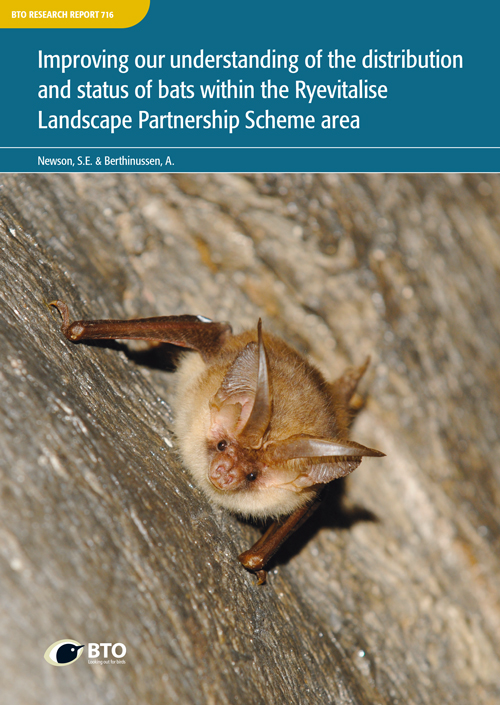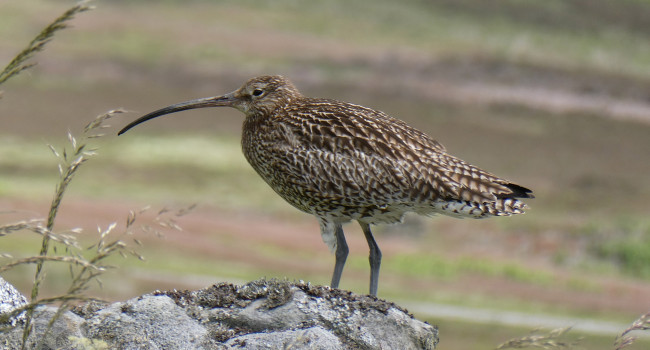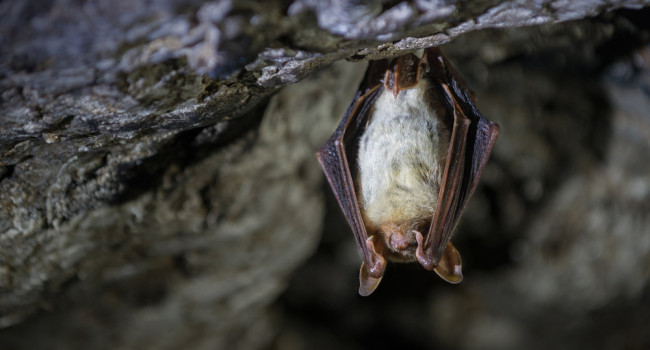Improving our understanding of the distribution and status of bats within the Ryevitalise Landscape Partnership Scheme area
Author(s): Newson S.E., Berthinussen A.
Published: February 2019 Issue No.: 716
Publisher: British Trust for Ornithology Pages: 52pp
ISBN: 9781912642021
Download article 3.62 MB application/pdf
Abstract
EXECUTIVE SUMMARY
1. This project aims to improve our understanding of the distribution and status of all species of bats within the Ryevitalise Landscape Partnership Scheme area, utilising the BTO Acoustic Pipeline. Specifically, the proposed work has the following objectives: (a) to work with the North York Moors National Park Authority to undertake a desk-based study to collate existing information on the distribution and activity of all species of bats within the Ryevitalise Landscape Partnership Scheme area; (b) to design and implement survey work in 2018 that provides large-scale data on bat distribution and activity in the Ryevitalise Landscape Partnership Scheme area. In addition, the report aims to address the following points: (c) to identify “hotspots” for different species of bats within the Ryevitalise Landscape Partnership Scheme area; (d) to carry out habitat analyses of bat survey data that help to inform practical conservation action and future work; (e) to suggest methods and protocols for adapting the project to run in the longer-term as a large-scale volunteer-based project.
2. Prior to the start of the fieldwork, a desk-based study was carried out to collate existing bat records for the Ryevitalise Scheme area for the period 2000 to the present. Most bat records were provided by the North Yorkshire Bat Group, with some additional records obtained from the National Biodiversity Network (NBN). Anna Berthinussen was contracted to spend 30 days between mid-April and August 2018 to survey for bats. Survey locations were chosen prior to the start of the survey season according to a systematic survey design with a random starting point, to ensure representative geographic and habitat coverage. Static bat detectors were left out to record for four consecutive nights at each location.
3. Data from 100 different 1-km squares were surveyed for bats. This sample comprised 387 complete nights of recordings. 1,133,862 triggered recordings were collected which, following analyses and verification, were found to include 276,764 recordings containing one or more species of bat. The remaining recordings were mainly of bird calls.
4. Spatial models of bat distribution and activity were produced and predictive performance evaluated for all species of bats, except Alcathoe Bat for which there were too few records to model distribution and activity. Additional analyses were carried out to assess the importance of habitat type for each bat species at local and landscape scales.
5. The current data set has been valuable in defining patterns of occurrence and activity across the Ryevitalise Landscape Partnership area. Alcathoe Bat, Noctule and Whiskered Bat / Brandt’s Bat appear to be the most range restricted bat species, with the core distribution and activity of these species in the southern half of the study area. For Noctule, comparatively few 1-km squares recorded a high proportion of the total activity. Whilst Common and Soprano Pipistrelles were recorded almost everywhere where a detector was left out to record, Soprano Pipistrelle showed strong spatial clustering in activity at a small number of locations. Of eight Alcathoe Bat recordings, only three – from two locations – were typical for this species in closed habitat, where identification of this species is most straightforward.
6. Most of the relationships between bat occurrence and activity and habitat were in line with the current knowledge on the ecology of the species present.
7. Considering the results of the study, a number of recommendations for practical conservation action are proposed.
8. Beyond this study, there is the potential to continue and develop the survey work as a Citizen Science project. In the last section in the report, we draw on our experience of setting up and running similar volunteer projects in Norfolk and southern Scotland and in supporting Devon Wildlife Trust with their HLF funded Greater Horseshoe Bat project, and Bat Conservation Trust in developing national bat monitoring.







Share this page